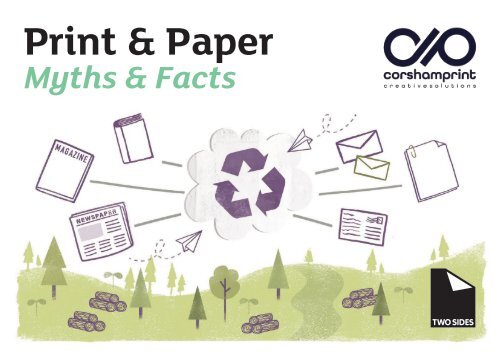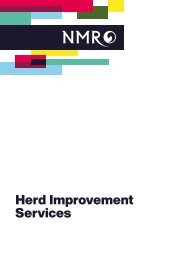Create successful ePaper yourself
Turn your PDF publications into a flip-book with our unique Google optimized e-Paper software.
<strong>Print</strong> & <strong>Paper</strong><br />
<strong>Myths</strong> & <strong>Facts</strong><br />
<strong>Print</strong> and <strong>Paper</strong><br />
have a great<br />
environmental<br />
story to tell<br />
www.twosides.info
02 The Fact - European forests have been<br />
growing by over 1,500 football pitches<br />
every day<br />
04 The Fact - <strong>Paper</strong> is one of the most<br />
recycled products in the world<br />
06 The Fact - <strong>Paper</strong> is one of the few truly<br />
sustainable products<br />
08 The Fact - Virgin fibres from<br />
sustainably managed forests are<br />
needed to maintain the paper cycle<br />
10 The Fact - Virgin fibres from<br />
sustainably managed forests are<br />
needed to maintain the paper cycle<br />
12 The Fact - <strong>Paper</strong> production is<br />
dependent on water, yet relatively little is<br />
consumed<br />
14 The Fact - Electronic communication<br />
also has environmental Impacts<br />
“ There aren’t many industries around<br />
that can aspire to becoming genuinely<br />
sustainable. The paper industry, however, is<br />
one of them; it is inherently sustainable.”<br />
Jonathon Porritt, Co-Founder, Forum for the Future<br />
16 The Fact - Many consumers value<br />
paper-based communication<br />
18 Glossary<br />
21 Sources
When it comes to the sustainability of<br />
<strong>Print</strong> and <strong>Paper</strong>, it’s important to separate<br />
the <strong>Facts</strong> from the <strong>Myths</strong>.<br />
The European paper industry is a world-leader<br />
when it comes to sustainably-sourced raw<br />
materials, renewable energy and recycling rates.<br />
Yet the myths around paper are still prevalent<br />
amongst consumers. A 2019 survey by Two Sides<br />
revealed 59% of European consumers believe<br />
European forests are shrinking, when in fact they<br />
have been growing by an area equivalent to 1,500<br />
football pitches every day. A third of consumers<br />
believe paper is a wasteful product and a quarter<br />
believe paper is bad for the environment.<br />
Often the source of these misconceptions is the<br />
abundance of misleading information about paper<br />
and its impact on the environment.<br />
<strong>Paper</strong> has been the preferred communications<br />
medium for 2,000 years. Even in today’s digital<br />
world, it continues to be highly effective and,<br />
produced, used and disposed of responsibly, is<br />
inherently sustainable.<br />
Two Sides seeks to ensure that, by fostering<br />
a better understanding of our industry’s<br />
environmental credentials, <strong>Print</strong> and <strong>Paper</strong>,<br />
through its myriad of uses, from commercial<br />
applications to the basis of learning and<br />
creativity, remains an essential medium for<br />
many generations to come.<br />
About Two Sides<br />
Two Sides is a not for profit, global initiative<br />
promoting the unique sustainable and attractive<br />
attributes of print, paper and paper packaging.<br />
Two Sides’ members span the entire print, paper<br />
and packaging value chain including: forestry,<br />
pulp, paper, packaging, inks and chemicals,<br />
finishing, publishing, printing, envelopes and<br />
postal operators.<br />
Find out more at www.twosides.info<br />
<strong>Print</strong> and <strong>Paper</strong><br />
have a great<br />
environmental<br />
story to tell<br />
www.twosides.info
THE MYTH<br />
European forests<br />
are shrinking<br />
THE FACT<br />
European forests have<br />
been growing by over<br />
1,500 football pitches<br />
every day<br />
02
In Europe, where almost all primary forests are protected, paper comes<br />
from sustainably managed forests where the cycle of planting, growing and<br />
logging is carefully controlled.<br />
“More than 90% of the pulpwood<br />
we use is sourced from the EU”<br />
CEPI Sustainability Report, 2018<br />
In some countries, particularly in the tropics, there<br />
are issues over land rights and natural forest<br />
conversion to industrial plantations which are a<br />
cause of concern to the paper industry, NGOs<br />
and consumers alike.<br />
The Two Sides initiative supports solutions to<br />
these problems and recognises the need to<br />
promote products which can clearly be traced to<br />
sustainable sources.<br />
Between 2005 and 2015, European forests<br />
grew by 44,000 Square Kilometres - that’s an<br />
area bigger than Switzerland and amounts<br />
to over 1,500 football pitches every day!<br />
FAO data, 2005-2015<br />
50% of the world’s wood harvest is used<br />
as fuel. Over 30% is processed for other<br />
industrial uses, such as construction and<br />
furniture. Only around 13% is used to<br />
make paper.<br />
Derived from FAOSTAT, 2018<br />
Protected areas constitute an important<br />
element of forest protection strategies.<br />
Around 44% of the EU territory is under<br />
Natura 2000 protection. The aim is to protect<br />
Europe’s most valuable and threatened<br />
habitats and species. Forests make up<br />
almost half of the area of Natura 2000 sites<br />
(i.e. 37.5 million ha) and 23% of all forests in<br />
Europe are within Natura 2000 sites.<br />
EEA, European Forest Ecosystems – State and Trends, 2016<br />
More than 60% of forests in EU‐28 are<br />
certified, mostly under the FSC or PEFC or<br />
both. The proportion of certified forests in<br />
Europe is substantial compared with the<br />
world as a whole, as only 12% of the world’s<br />
forest areas are certified.<br />
EEA, European Forest Ecosystems – State and Trends, 2016<br />
The most common pressures causing<br />
deforestation and severe forest degradation<br />
are: large and small-scale agriculture,<br />
unsustainable logging, mining,<br />
infrastructure projects, and increased fire<br />
incidence and intensity.<br />
WWF, Deforestation Fronts website, 2018<br />
Today forests and other wooded land in<br />
the EU‐28 amount to about 180 million<br />
hectares, making Europe one of the most<br />
forest‐rich regions in the world, with more<br />
than 42% of its land covered by forests.<br />
EEA, Landscapes in Transition, 2017.<br />
03
THE MYTH<br />
<strong>Paper</strong> is a<br />
wasteful product<br />
THE FACT<br />
<strong>Paper</strong> is one of the<br />
most recycled products<br />
in the world
The European paper industry is a leading recycler and, with local collecting<br />
systems improving, will increase its recycling rates even further.<br />
The European paper recycling rate is 72.3%, which<br />
is approaching the practical theoretical maximum<br />
recycling rate of 78%. 1 Some paper products<br />
cannot be recovered for recycling because<br />
they are kept for long periods of time (books)<br />
or archived (records); others are destroyed or<br />
contaminated when used (e.g. tissue and hygienic<br />
paper).<br />
<strong>Paper</strong> is recycled, on average, 3.6 times a year<br />
in Europe 1 , while 54% of the fibre for Europe’s<br />
paper industry is from paper for recycling. 2 <strong>Paper</strong><br />
cannot be recycled indefinitely as fibres get too<br />
short and worn out to be useful in creating a new<br />
sheet of paper. More importantly, the production<br />
cannot be based on 100% recycled fibre, as 100%<br />
of consumption cannot be collected, and Europe is<br />
also a global net exporter of paper which is then<br />
consumed and collected outside of Europe. The<br />
cycle must therefore constantly be refilled with<br />
new fibres from sustainably managed forests.<br />
While the EU is discussing how to transition<br />
to a circular economy, the paper fibre loop<br />
can serve as a model for circularity. <strong>Paper</strong><br />
recycling is an industry ‘Made in Europe’.<br />
It prolongs value creation and creates job<br />
opportunities in Europe from a renewable,<br />
predominantly European resource, wood.<br />
European <strong>Paper</strong> Recycling Council, 2018<br />
Exported<br />
15.9%<br />
Recycled<br />
72.3%<br />
“Two Sides members support<br />
the implementation of effective<br />
recycling schemes and the<br />
minimisation and eventual<br />
elimination, of print and paper<br />
waste in landfill.”<br />
Two Sides Membership Charter<br />
22%<br />
5.7%<br />
Non-recoverable (e.g.<br />
tissue, wallpaper, etc.)<br />
Two Sides encourages responsible paper<br />
consumption. Double-sided printing in the office<br />
and separate collection schemes will reduce costs<br />
and improve sustainability.<br />
Used in Europe<br />
84.1%<br />
Potential for further recovery<br />
Recovery of European <strong>Print</strong> and <strong>Paper</strong><br />
waste products (CEPI/EPRC statistics)<br />
05
THE MYTH<br />
<strong>Paper</strong> is bad for<br />
the environment<br />
THE FACT<br />
<strong>Paper</strong> is one of the few truly<br />
sustainable products<br />
06
<strong>Paper</strong> is based on wood, a natural and renewable material. As trees grow they<br />
absorb CO 2 from the atmosphere. Furthermore, as a wood product, paper also<br />
continues to store carbon throughout its lifetime.<br />
Sustainability <strong>Facts</strong><br />
• <strong>Paper</strong> is made from wood, a truly<br />
renewable and sustainable resource.<br />
The paper industry uses respected certification<br />
schemes to ensure that the paper you use<br />
originates from a sustainable forest source.<br />
The two most recognised certification schemes<br />
are the Forest Stewardship Council® (FSC®) and<br />
the Programme for the Endorsement of Forest<br />
Certification (PEFC).<br />
Both PEFC and FSC are committed to achieving<br />
the same objectives – the certification of forests<br />
to credible, independently verified standards of<br />
responsible forest management, and focus on<br />
conserving the natural habitats of plants and<br />
animals and respecting the rights of forestry<br />
workers and local communities. Both PEFC and<br />
FSC operate robust chain of custody schemes that<br />
track wood and wood fibre through every step of<br />
the supply chain, from the forest to the end user.<br />
FSC is an international non-profit, multistakeholder<br />
organisation established<br />
in 1993 to promote responsible<br />
management of the world’s forests. The FSC logo<br />
when used on paper and printed products is<br />
assurance that it is made with, or contains, wood<br />
that comes from FSC certified forests or from postconsumer<br />
waste.<br />
For more information visit www.fsc.org<br />
PEFC is an independent, non-profit,<br />
non-governmental organisation, founded<br />
in 1999 which promotes sustainably<br />
managed forests through independent thirdparty<br />
certification. The PEFC logo provides an<br />
assurance to purchasers of paper products that<br />
the woodfibre originates from PEFC certified,<br />
sustainably managed forests.<br />
For more information visit www.pefc.org<br />
Forests are rich in biodiversity and valuable<br />
for recreation, water regulation and soil<br />
protection. As well as for providing timber<br />
and other non-wood forest products, forests<br />
are important for mitigating climate<br />
change and for the renewable energy sector<br />
— over a single year, a mature tree will<br />
take up approximately 22 kg of CO2 from<br />
the atmosphere, and, in exchange, release<br />
oxygen.<br />
EEA, European Forest Ecosystems – State and Trends, 2016<br />
• Forest certification ensures wood<br />
comes from well managed forests.<br />
• Responsible wood, pulp and<br />
paper production ensures healthy<br />
growing forests.<br />
• Between 2005 and 2015, European<br />
forests grew by an area the size<br />
of Switzerland. 3<br />
• 71% of wood and 83% of pulp<br />
purchased by the European<br />
pulp and paper industry is FSC<br />
or PEFC certified. 4<br />
• 91% of production capacity is<br />
certified or registered according<br />
to the internationally recognised<br />
environmental management<br />
standards ISO 14001 and EMAS. 5 07
THE MYTH<br />
Only recycled paper<br />
should be used<br />
THE FACT<br />
Virgin fibres from<br />
sustainably managed<br />
forests are needed to<br />
maintain the paper cycle<br />
08
Without new fibres, from new trees, the paper cycle cannot be maintained. Recycled fibres degrade after several uses<br />
and the paper industry needs fresh fibre from sustainably managed forests to keep the renewable cycle going.<br />
Europe is the world leader when it comes to<br />
recycling paper. 72.3% of our paper is now<br />
recycled. 1 This means more recycled fibres are<br />
being used as a raw material by Europe’s paper<br />
producers. In 1991, paper for recycling made up<br />
40% of fibre used, compared to 60% virgin fibre.<br />
In 2017, paper for recycling made up 54% of fibre<br />
used, compared to 47% virgin fibre. 2<br />
This growth in recycled fibres being used has<br />
slowed down in recent years as total paper for<br />
recycling in Europe reaches nearer to its practical<br />
maximum (see p.5). It is therefore likely that the<br />
current balance of recycled and virgin fibres<br />
will remain steady. It is very difficult to directly<br />
compare recycled fibre with virgin fibre as both are<br />
fundamental to the paper making process.<br />
The paper making process really is a sustainable<br />
cycle. Recycled fibres are used as effectively as<br />
possible, whilst new fibres are constantly brought<br />
in to replenish and maintain the process.<br />
A fibre can be recycled several times, yet<br />
not indefinitely, depending on the paper<br />
grade. Therefore, there is a continuous need<br />
to feed the inflow of recovered fibre with<br />
paper products made of virgin pulp. <strong>Paper</strong><br />
recycling needs to continuously incorporate<br />
a certain amount of fresh fibres for three<br />
main reasons: strength, quality and<br />
availability.<br />
European <strong>Paper</strong> Recycling Council, 2017.<br />
Collecting paper for recycling, ensuring<br />
fibres remain available for remanufacture,<br />
is key to sustainability.<br />
• When buying paper, whether recycled paper<br />
or virgin paper, ensure that it is made with<br />
wood from sustainably managed forests<br />
• Virgin fibre grades are needed to continue<br />
the cycle<br />
• Recycled fibres degrade after several uses<br />
Recycled paper can be used in some grades<br />
more than others. For example, newsprint and<br />
some types of packaging are often made with<br />
100% recycled fibre. High grade graphic papers,<br />
however, have a lower utilisation rate, around<br />
13% 2 , but when recycled, inject the cycle with<br />
virgin fibres.<br />
09
THE MYTH<br />
<strong>Paper</strong> production<br />
is a major cause of<br />
global greenhouse<br />
gas emissions<br />
THE FACT<br />
Most of the energy used is renewable<br />
and carbon intensity is surprisingly low<br />
10
The European pulp and paper industry produces original bio-based products using wood, a renewable material. It is<br />
also the biggest single industrial user and producer of renewable energy in the EU: 60% of the industry’s total fuels<br />
consumption is biomass-based. 3 And the industry has the potential to do even more in the future. It has the experience,<br />
technology and supply chain to play a big part in the bioeconomy and to do so in a resource efficient manner.<br />
The environmental impact of our personal paper<br />
consumption may not be as high as you think<br />
either. In Europe, we each use an average of<br />
125kg of paper every year. 6 This amount of paper<br />
produces 84kg of CO 2<br />
7<br />
which is equal to driving<br />
about 500 miles in the average European car. 8 By<br />
buying paper from sustainably managed forests<br />
and always recycling, we really do not have to<br />
feel guilty about using this natural and renewable<br />
product.<br />
The paper and printing sector is one of the<br />
lowest industrial emitters of greenhouse<br />
gases, accounting for less than 1% of all EU<br />
greenhouse gas emissions (around 4% of all<br />
manufacturing emissions).<br />
Based on Eurostat data, 2016.<br />
The paper products and printing sector is<br />
one of the lowest industrial greenhouse<br />
gas emitters. Manufacturing industries<br />
account for 24% of all EU greenhouse gas<br />
emissions:<br />
• Non-metallic mineral products 5.6%<br />
• Basic metals 4.8%<br />
• Chemicals and chemical products 4.3%<br />
• Coke and refined petroleum 4.0%<br />
• Food, beverages and tobacco 1.7%<br />
• <strong>Paper</strong> and paper products 0.9%<br />
• <strong>Print</strong>ing and recorded media 0.1%<br />
• Other manufacturing 2.3%<br />
Based on Eurostat data, 2016.<br />
The direct CO2 emissions of the<br />
European pulp and paper industry<br />
reduced by 25% between 2005<br />
and 2017.<br />
CEPI, Key Statistics, 2017.<br />
11
THE MYTH<br />
<strong>Paper</strong> production<br />
consumes an<br />
excessive amount<br />
of water<br />
THE FACT<br />
<strong>Paper</strong> production is dependent on water,<br />
yet relatively little is consumed<br />
12
The pulp and paper industry depends on water in three crucial areas. Firstly, there is rain water that is essential for<br />
trees to grow, and, through photosynthesis, transform carbon dioxide to oxygen and cellulose; the latter provides the<br />
industry’s primary raw material - wood fibre. Then there is water that is actually used to make pulp and paper and<br />
finally, there is the suitably treated effluent.<br />
As water is a crucial resource for the industry, most<br />
pulp and paper mills are located near to abundant<br />
supplies. It is also important to recognise that<br />
intake does not equal consumption, because most<br />
of the water will be returned to the environment. In<br />
fact, 93% of the water used in the European paper<br />
industry is returned, having been reused within the<br />
mill before being suitably treated. 9<br />
93% of water we use is returned to the<br />
environment in good quality, with the<br />
remainder either being evaporated, staying<br />
within the product, or being bound-up in<br />
solid waste.<br />
CEPI, Water Profile in 2015<br />
Members’ use of process water, measured in<br />
cubic metres per metric ton of production,<br />
was reduced by 7.2% from the 2004/2005<br />
baseline.<br />
International Council of Forest & <strong>Paper</strong> Associations<br />
(ICFPA), 2017<br />
Around 40% of total water use [in Europe]<br />
is accounted for by agriculture, followed by<br />
28% for cooling and 18% for manufacturing<br />
and mining, while public water supplies<br />
account for 14%.<br />
European Environment Agency, 2018.<br />
Forested watersheds and wetlands supply 75% of<br />
the world’s accessible fresh water for domestic,<br />
agricultural, industrial and ecological needs.<br />
Forests influence the amount of available water<br />
and regulate surface and groundwater flows while<br />
maintaining highest water quality. Forests reduce<br />
the effects of flooding, and prevent and reduce<br />
dryland salinity and desertification. Forests act as<br />
natural water filters, minimizing soil erosion on site<br />
and reduce sediment in water bodies. 10<br />
Improvements in papermaking techniques and<br />
water treatment have had a dramatic effect on<br />
the cleanliness of effluent leaving the mill. Since<br />
1991 there has been a 95% reduction in AOX<br />
levels (a measure of the toxicity due to chlorine<br />
compounds) and a 77% reduction in COD<br />
(Chemical Oxygen Demand – how much oxygen<br />
is consumed by the decomposition of organic<br />
matter). 2<br />
13
THE MYTH<br />
Electronic communication<br />
is better for the<br />
environment than paperbased<br />
communication<br />
THE FACT<br />
Electronic communication also<br />
has environmental Impacts<br />
14
“Go <strong>Paper</strong>less”, “Go Green” and “Save Trees” are common messages seen these days as many organisations encourage<br />
their customers to switch to electronic transactions and communications. But are these appeals based on fact?<br />
These sort of messages give the impression that<br />
electronic communication is more environmentally<br />
friendly than traditional, paper-based<br />
communication. But it is very difficult to make such<br />
a statement without considering the full lifetime of<br />
those different mediums.<br />
As has been discussed throughout this booklet,<br />
paper is a uniquely renewable and sustainable<br />
product. The main raw material, wood, is grown<br />
and harvested in a carefully controlled and<br />
sustainable way - so sustainable, in fact, that<br />
European forests, where most of the raw material<br />
comes from, have grown by an area the size of<br />
Switzerland in just 10 years. 3<br />
The environmental impacts of our ever-increasing<br />
digital world cannot be ignored. The ICT industry<br />
accounts for around 2.5-3% of global greenhouse<br />
gas emissions and this is predicted to rise to 14%<br />
by 2040. 11<br />
Businesses and individuals are increasingly using<br />
‘cloud’ services. These mega data-centres store<br />
almost everything we do online; including our web<br />
searches, our social media posts and our<br />
online statements.<br />
When it comes to communication, whether it’s<br />
electronic or traditional mediums, consumers must<br />
be informed about the environmental impacts of<br />
those activities. Two Sides advises businesses to<br />
be transparent about the carbon footprint of all<br />
their services.<br />
Tackling Greenwash<br />
To date, over 500 of the world’s largest<br />
organisations have been found to be using<br />
greenwash statements in their communications.<br />
Of those, around 70% have removed their<br />
misleading statements as a direct result of being<br />
challenged by Two Sides.<br />
It is important to mention that not all<br />
greenwashing is due to purposely misleading<br />
customers. Often it is down to genuine and<br />
common misconceptions about <strong>Print</strong> and <strong>Paper</strong>.<br />
It is Two Sides’ role to educate both consumers<br />
and businesses alike.<br />
By 2040, the ICT carbon footprint could<br />
account for as much as 14% of the total<br />
worldwide footprint at the 2016 level, and<br />
hence exceed the current relative footprint<br />
of the Agriculture sector (9%), and almost<br />
half of the current total footprint of the<br />
industrial sector (29%) in the United States.<br />
Journal of Cleaner Production, 2018<br />
The electronic waste problem is colossal,<br />
and it’s growing. In 2016 alone, 44.7 million<br />
tonnes of e-waste were generated globally,<br />
of which 435 thousand tonnes were mobile<br />
phones, representing more than the mass of<br />
the Empire State Building.<br />
Ellen MacArthur Foundation, 2018<br />
15
THE MYTH<br />
Digital is the<br />
preferred means of<br />
communication<br />
THE FACT<br />
Many consumers value<br />
paper-based communication<br />
16
Many organisations, banks, utilities, telecoms and governments are now<br />
increasingly going online or making charges if their customers wish to<br />
receive paper-based communication.<br />
But switching to digital is not always welcome.<br />
Two Sides understand the value and convenience<br />
of the digital revolution but believe that citizens<br />
must continue to have a right to receive paperbased<br />
communications, particularly bills and<br />
statements, without penalties, supplementary<br />
charges or difficulty.<br />
Often it is the most vulnerable members of society<br />
that depend on traditional, postal, transactional<br />
mail. The move to an online-only society risks<br />
leaving older people, the disabled, rural dwellers<br />
and those on low incomes disconnected.<br />
It is important for policy makers to acknowledge<br />
that information on paper is preferred by many<br />
consumers and often receives more attention.<br />
Consumers wish to retain the flexibility of postal<br />
and electronic communications.<br />
In reality we live in an increasingly digital<br />
world where electronic and paper-based<br />
communications coexist and are often<br />
complementary. Communication strategies must<br />
not only be cost effective but also recognise<br />
citizen choice. There are many tangible benefits<br />
that paper-based documentation can bring and<br />
its preference as a means of communication by<br />
many consumers must be at the forefront of any<br />
digital planning.<br />
We believe that it is every consumer’s<br />
right to choose, without disadvantage,<br />
how they are contacted by banks and<br />
other financial service companies, utility<br />
companies, media companies and other<br />
service providers. Increasingly businesses<br />
are restricting access to paper bills and<br />
statements and denying their customers an<br />
informed choice.<br />
Keep Me Posted, 2018<br />
<strong>Print</strong> and <strong>Paper</strong> in A Digital World<br />
An international survey of over 10,700 consumers,<br />
commissioned by Two Sides in 2017, found:<br />
• Consumers worldwide prefer to read the<br />
printed version of books (72%), magazines<br />
(72%) and newspapers/news (55%) over<br />
digital options. Many respondents also<br />
indicated that reading in print is more<br />
enjoyable than reading electronically.<br />
• More consumers believe they gain a deeper<br />
understanding of news stories when reading<br />
from print media (65%) over online news<br />
sources (49%). In addition, consumers<br />
also trust the stories they read in printed<br />
newspapers (51%) more than stories found on<br />
social media (24%).<br />
• Many consumers (68%) do not pay attention<br />
to online advertisements and 57% do their<br />
best to avoid them. 46% would be more<br />
likely to take an action after seeing an<br />
advertisement in a printed newspaper or<br />
magazine than they would if they saw the<br />
same ad online.<br />
• 89% of consumers believe that they should<br />
have the right to choose how they receive<br />
communications (printed or electronically), at<br />
no extra charge, from financial organisations<br />
and service providers.<br />
17
GLOSSARY<br />
18<br />
Afforestation: Afforestation is the conversion from<br />
other land uses into forest, or the increase of the<br />
canopy cover to above the 10% threshold.<br />
Biodiversity: the variability among living organisms<br />
from all sources including, inter alia, terrestrial,<br />
marine and other aquatic ecosystems and the<br />
ecological complexes of which they are part; this<br />
includes diversity within species, between species<br />
and of ecosystems.<br />
Bioenergy: renewable energy made from biofuels<br />
derived from organic matter or other biological<br />
sources.<br />
Biomass: as a renewable energy source, refers to<br />
living and recently dead biological material that<br />
can be used as fuel or for industrial production.<br />
Chain of Custody (CoC): a wood flow accounting<br />
system applied by an enterprise to trace the flow<br />
of wood from certified forests or non-certified<br />
forests to the end product.<br />
Climate change: long-term significant change in<br />
the expected patterns of average weather of a<br />
specific region over an appropriately significant<br />
period of time.<br />
Collection (of paper and board): separate<br />
collection of paper and paper products from<br />
industrial and commercial outlets, from<br />
households and offices for Recycling. (Collection<br />
includes transport to the sorting/processing or<br />
recycling plant/paper mill).<br />
Consumer: industrial, commercial or private enduser.<br />
Deforestation: the conversion of forest to another<br />
land use or the long-term reduction of the tree<br />
canopy cover below the minimum 10% definition<br />
for forests.<br />
Eco-label: a labelling system that verifies that<br />
consumer products are made in a way that<br />
environmental aspects are considered and<br />
negative effects are minimized.<br />
Forest area: area with a minimum 10% minimum<br />
crown cover. The definition includes both natural<br />
forests and forest plantations. It excludes stands<br />
of trees established primarily for agricultural<br />
production.<br />
Forest certification: a system for verifying that<br />
a forest is being managed according to the<br />
requirements of a forest management standard.<br />
Forest management: a range of human<br />
interventions that affect forest ecosystems.<br />
Forest restoration: renewing a degraded,<br />
damaged, or destroyed forest ecosystem through<br />
active human intervention.<br />
<strong>Paper</strong> for recycling: used paper and board<br />
separately collected and in general pre-processed<br />
according to the European Standard List of<br />
Recovered <strong>Paper</strong> and Board Grades (EN 643).<br />
<strong>Paper</strong>: term used to cover all grades of paper and<br />
board.<br />
Primary forest: naturally regenerated forest of<br />
native species, where there are no clearly visible<br />
indications of human activities and the ecological<br />
processes are not significantly disturbed.<br />
Production forest: forest area designated primarily<br />
for production of wood, fibre, bio-energy and/or<br />
non-wood forest products.<br />
Recovered paper: outdated term used for <strong>Paper</strong><br />
for recycling.<br />
Recyclability: design, manufacturing and<br />
converting of paper-based products in such a<br />
way as to enable a high quality recycling of fibres<br />
and other materials in a manufacturing process<br />
in compliance – where appropriate – with current<br />
standards in the Community: as a minimum,<br />
recyclability requires that sufficient information is<br />
exchanged for appropriate risk management and<br />
safe re-use of fibres.<br />
Recycling rate: the ratio between recycling of used<br />
paper, including net trade of paper for recycling,<br />
and paper and board consumption.<br />
Recycling: reprocessing of used paper in a<br />
production process into new paper and board.<br />
Reforestation: reforestation is the re-establishment<br />
of forest formations after a temporary condition<br />
with less than 10% canopy cover due to humaninduced<br />
or natural causes e.g. forest fires.
Sustainable forest management: the stewardship<br />
and use of forests and forest lands in a way,<br />
and at a rate, that maintains their biodiversity,<br />
productivity, regeneration capacity, vitality and<br />
their potential to fulfil, now and in the future,<br />
relevant ecological, economic and social functions,<br />
at local, national, and global levels, and that does<br />
not cause damage to other ecosystems.<br />
Utilisation rate: percentage of paper for recycling<br />
utilisation compared to the total paper & board<br />
production.<br />
From newspapers to magazines, from<br />
photocopies to leaflets, we believe <strong>Print</strong> and<br />
<strong>Paper</strong> cannot be beaten for attractiveness,<br />
impact and sustainability.<br />
This booklet can only scratch the surface of all<br />
the facts surrounding the responsible use of<br />
print and paper.<br />
To learn more about the production and<br />
consumption of paper, go to the Two Sides<br />
website and discover the facts about our<br />
industry.<br />
www.twosides.info<br />
Glossary sources:<br />
Confederation of European <strong>Paper</strong> Industries<br />
Food and Agriculture Organization of The United Nations<br />
19
What a great,<br />
sustainable idea
SOURCES<br />
1. European <strong>Paper</strong> Recycling Council, Monitoring Report 2017.<br />
2. CEPI Key Statistics, 2017.<br />
3. Food and Agriculture Organization of the United Nations (FAO),<br />
Global Forest Resources Assessment 2005 – 2015.<br />
4. Based on Two Sides analysis of FSC and PEFC published data, 2017.<br />
5. CEPI Sustainability Report, 2018.<br />
6. Food and Agriculture Organization of the United Nations (FAO),<br />
Forest Products Yearbook 2016.<br />
7. Based on a nominal 670kg CO 2e/tonne carbon footprint for paper (EURO-<br />
GRAPH estimate).<br />
8. Based on average of 118.5g CO 2/km for new cars sold in 2017.<br />
9. CEPI, Water Profile in 2015.<br />
10. European forest sector press release, 2016.<br />
11. Belkhir L & Elmeligi A, Journal of Cleaner Production: Assessing ICT global<br />
emissions footprint: Trends to 2040 & recommendations, 2018.<br />
© Two Sides 2019<br />
The information contained within this booklet is carefully researched using third party sources. Two Sides accepts no liability for inaccurate information.<br />
Illustrations: © Holly Sims www.hollysims.co.uk
Corsham <strong>Print</strong><br />
Unit 4, Leafield Way<br />
Corsham<br />
SN13 9SW<br />
+44 (0)1225 812930<br />
info@corshamprint.co.uk<br />
www.corshamprint.co.uk<br />
Two Sides<br />
iCon Centre<br />
Eastern Way<br />
Daventry<br />
NN11 0QB<br />
United Kingdom<br />
+44 (0)1327 262920<br />
enquiries@twosides.info<br />
www.twosides.info<br />
@TwoSidesUK Version 10, May 2019

















